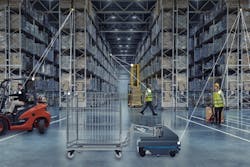Making Mobile Robots More Flexible in the Plant
MIT Professor David Mindell has spent his career defying traditional distinctions between disciplines. His work has explored the ways humans interact with machines, drive innovation, and maintain societal well-being as technology transforms our economy.
Mindell’s experience combining fields of study has shaped his ideas about the relationship between humans and machines. Those ideas are what led him to found Humatics—a startup named from the merger of “human” and “robotics.”
Humatics is trying to change the way humans work alongside machines, by enabling location tracking and navigation indoors, underground, and in other areas where technologies like GPS are limited. It accomplishes this by using radio frequencies to track things at the millimeter scale—unlocking what Mindell calls microlocation technology.
The company’s solution is already being used in places like shipping ports and factories, where humans work alongside cranes, industrial tools, automated guided vehicles (AGVs), and other machines. These businesses often lack consistent location data for their machines and are forced to adopt inflexible routes for their mobile robots.
“One of the holy grails is to have humans and robots share the same space and collaborate, and we’re enabling mobile robots to work in human environments safely and on a large scale,” Mindell says. “Safety is a critical first form of collaboration, but beyond that, we’re just beginning to learn how to work [in settings] where robots and people are exquisitely aware of where they are.”
The interdisciplinary perspective Mindell forged at MIT has helped him identify the limitations of technology that prevent machines and humans from working together seamlessly.
One particular shortcoming that Mindell has thought about for years is the lack of precise location data in places like warehouses, subway systems, and shipping ports.
“In five years, we’ll look back at 2019 and say, ‘I can’t believe we didn’t know where anything was,’” Mindell says. “We’ve got so much data floating around, but the link between the actual physical world we all inhabit and move around in and the digital world that’s exploding is really still very poor.”
In 2014, Mindell partnered with Humatics co-founder Gary Cohen, who has worked as an intellectual property strategist for biotech companies in the Kendall Square area, to solve the problem.
In the beginning of 2015, Mindell collaborated with Lincoln Laboratory alumnus and radar expert Greg Charvat; the two built a prototype navigation system and started the company two weeks later. Charvat became Humatics’ CTO and first employee.
“It was clear there was about to be this huge flowering of robotics and autonomous systems and AI, and I thought the things we learned in extreme environments, notably under sea and in aviation, had an enormous amount of application to industrial environments,” Mindell says. “The company is about bringing insights from years of experience with remote and autonomous systems in extreme environments into transit, logistics, e-commerce, and manufacturing.”
Bringing microlocation to industry
Factories, ports, and other locations where GPS data is unworkable or insufficient adopt a variety of solutions to meet their tracking and navigation needs. But each workaround has its drawbacks.
RFID and Bluetooth technologies, for instance, can track assets but have short ranges and are expensive to deploy across large areas.
Cameras and sensing methods like LIDAR can be used to help machines see their environment, but they struggle with things like rain and different lighting conditions. Floor tape embedded with wires or magnets is also often used to guide machines through fixed routes, but it isn’t well-suited for today’s increasingly dynamic warehouses and production lines.
Humatics has focused on making the capabilities of its microlocation location system as easy to leverage. The location and tracking data it collects can be integrated into whatever warehouse management system or IOT platforms customers are already using.
Its radio frequency beacons have a range of up to 500 meters and, when installed as part of a constellation, can pinpoint three dimensional locations to within 2 centimeters, creating a virtual grid of the surrounding environment.
The beacons can be combined with an onboard navigation hub that helps mobile robots move around dynamic environments. Humatics’ system also gathers location data from multiple points at once, monitoring the speed of a forklift, helping a crane operator place a shipping crate, and guiding a robot around obstacles simultaneously.
The data Humatics collects also transforms the way workers and machines share space and work together.
Indeed, with a new chip just emerging from its labs, Mindell says Humatics is moving industries such as manufacturing and logistics into “the world of ubiquitous, millimeter-accurate positioning.”
This article originally appeared in MIT news. It has been edited and is used with permission.
